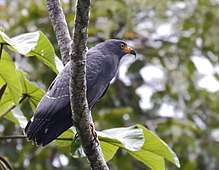Slender-billed kite
The slender-billed kite (Helicolestes hamatus)[2][3] is a bird of prey in the family Accipitridae, which also includes the eagles, hawks and Old World vultures. It is found near water in forested parts of tropical northern and central South America, and far eastern Panama.
.jpg)
| Slender-billed kite | |
|---|---|
 | |
| A juvenile slender-billed kite at Careiro da Várzea, Amazonas state, Brazil | |
| Scientific classification | |
| Kingdom: | Animalia |
| Phylum: | Chordata |
| Class: | Aves |
| Order: | Accipitriformes |
| Family: | Accipitridae |
| Genus: | Helicolestes Bangs & T.E Penard, 1918 |
| Species: | H. hamatus |
| Binomial name | |
| Helicolestes hamatus (Temminck, 1821) | |
| Synonyms | |
|
Rostrhamus hamatus | |
Description
Both genders resemble the male snail kite, and the slender-billed kite has often been included in the same genus, Rostrhamus. Adults always have yellow eyes and the all-dark tail is noticeably shorter than in the snail kite. Immatures resemble adults, but have brownish eyes and three (incl. tip) narrow white bands in the tail.
Diet
As in the snail kite, the unusually shaped bill is an adaption for feeding on aquatic snails, and while it sometimes takes crabs, it mainly feeds on snails of the genus Pomacea.
References
- BirdLife International (2012). "Helicolestes hamatus". IUCN Red List of Threatened Species. 2012. Retrieved 26 November 2013.CS1 maint: ref=harv (link)
- Resurrect the monotypic genus Helicolestes for the Slender-billed Kite
- A classification of the bird species of South America
External links
- Slender-billed Kite (adult) photo. mountainpath.
- Slender-billed Kite (immature) photo. altabpe00.
